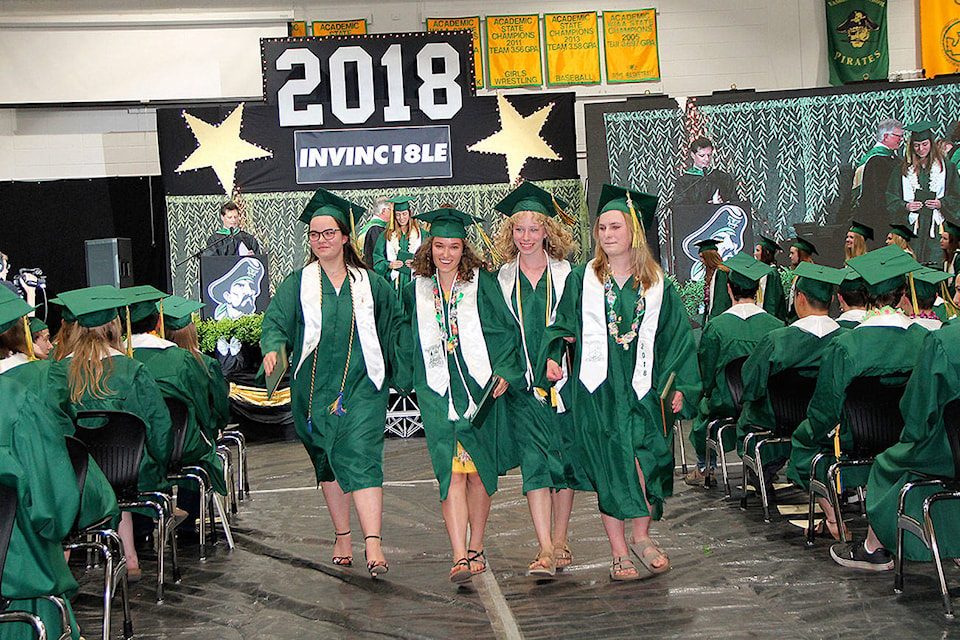There was a time the Greater Victoria School District had a dismal completion rate for high school students.
But in 2018, SD61 celebrated its 10th straight year of increases, hitting an 86.8 per cent completion rate.
It’s a massive increase from 2008-09 school year, that SD61 had a grad rate of about 71.1 per cent, and is now 3.1 per cent above the provincial rate of 83.7 per cent. It’s also among the higher rates in the country, which hovers around 85 per cent.
“Educationally, we’ve turned some different directions since 08-09,” said Green, explaining the completion rates increased due to a number initiatives. Green describes each initiative as a “layer” of support that keep each student engaged, and it’s taken multiple layers, she said.
Key among them is the development of the Partners and Pathways program that introduced career-based programming to students as young as 11, in Grade 6.
“We knew we needed to get started earlier, to let kids know what’s out there,” Green said. “In Grades 6-7-8 [they need to] know what is out there for them to follow when they graduate is. It’s not just the college/university idea but the other options.”
Trades and specialized careers that never existed are key drivers to be credited, Green said. Count the desire of trades and industry, such as aviation, wanting to come into the schools. This is in addition to colleges and universities, who have traditionally been keen partners, but who only appeal to a certain segment of student population.
“[Trades and industry] want students to have a baseline for skills before they graduate,” Green said. “These are areas of work that never existed.”
In summary, it’s about enabling students to look beyond the end of school and to prepare them for the transition, to whichever direction they go, through support networks and familiarity with the next stage.
There’s also the layer of social and emotional needs that weren’t as well recognized before. It’s no secret that students go through anxiety, with a belief that students were suffering anxiety at an increasing rate.
What SD61 did was to learn how to support students, and to better recognize the scenarios that build anxiety in students to anticipate when to support them.
“When we were at 71.1 per cent, our school district really looked at what else we could do, and we started tracking individual student [progress] from Grades 9 through 12,” Green said.
To do so SD61 set up a senior leadership team at each school.
“Vic High was one of my schools I met with,” Green recalled. “We looked at kids in Grades 11 and 12 who weren’t experiencing success in the courses they needed for graduation and, we made efforts into why there grades were slipping, and/or attendance falling.”
The response was to build trust, and a relationship, with the students, she said.
“Often times, kids going through things at home or just don’t know their pathway.”
Sometimes that was corrected through connection and a relationship, other times by adding a practicum, such as putting the student into a workplace environment.
“They become re-energized and ready to go, reigniting their passion,” Green said. “Once they get that excitement back we they follow through.”
That model continues in all seven SD61 high schools, with teachers tracking student grades over time.
“We enter intermittent data into the school data bank so the principal can bring up the students in English 10, and see that they’re falling off,” Green said. “If a student misses an assignment, staff can check in to see if were they just absent because of an illness, or other reasons.”
The strategies were just logical, and SD61 borrowed very little from other school districts. And it’s working so well, they’ve drawn attention from around the world.
“Keep in mind, 10 years ago we wouldn’t have had the technology and assessment pieces in tracking kids that we do now,” Green said. “[We took advantage] of trends over time of the work force retiring, and a panic that the work force would disappear for these trades and also new careers we never had before.”
